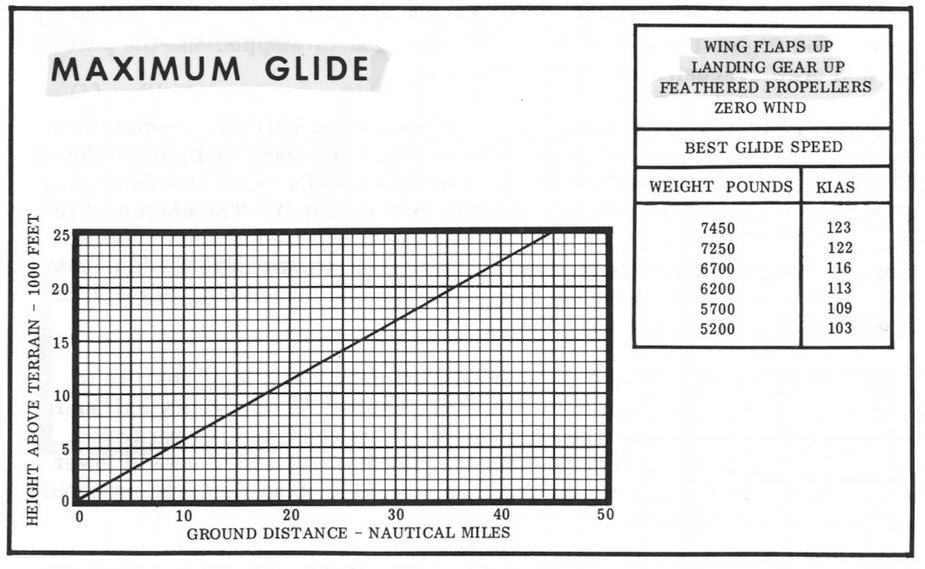I just re-watched the Air Crash Investigation episode about Tuninter Flight 1153 (spoiler alert in the next sentences). The airplane remained without fuel and glided to ditch in the sea. Leaving all the rest aside, tests were made to see if the same airplane in the same situation with feathered propellers and at best glide speed could have reached Palermo.
However the Seneca II I did my twin training on and fly, does not have a published best glide speed. My assumption is that the manufacturer does not expect the loss of both engines simultaneously so they concentrate on single engine operations. However a best glide speed would still be a very useful figure in some situations.
Is this an omission in the Seneca AFM or is it standard for twins to have no best glide speed published?
It is indeed true that these figures are not officially published.
If this is indeed so also for the ATR72, how did they expect the pilots to figure out and fly this speed (that they don’t have) in a stressful situation? Interesting… Leaving the propellers unfeathered is another matter but they were trying to restart the engines.
I have always assumed Blue Line, and that is where I would go, but I must admit this is only based on a feeling that Blue Line is probably where it is because it is the minimum drag speed, no hard data.
Timothy wrote:
I have always assumed Blue Line, and that is where I would go
I would do the same based on the same hunch.
You should fly faster than blue line. Vy is essentially the same as the speed for minimum sink and the best glide speed is always higher than the minimum sink speed.
Also, if you’re uncertain, it is better to fly too fast then too slow (within reason) — particularly if you have a headwind.
It might not be a requirement for part 23 aeroplanes to have published glide speeds and ranges, but quite a few manufacturers provide them. All the Cessna twins have them.
Here is an example for a C421B which I found on my computer:

Part 25 aircraft like this ATR must have glide speeds and distances in the flight manual. The problem is, those figures and graphs might be somewhat hidden in the manual so that it will be difficult to retrieve them and do the calculations in the short time remaining. I found those C421 glide figure not in the “Engine inoperative” part of the abnormal and emergency section of the manual, but under “Engine and electrical fire”. Quite easy when sitting at one’s desk, but almost impossible in the actual situation I would say…
But one should have memorised a rough figure for a best airspeed (or AoA) just in case. Like 115kt for the C421 at medium weight.
what_next wrote:
Like 115kt for the C421 at medium weight
…and how does that compare to Blue Line?
If there were a rule of thumb, like Blue Line, it would make it a lot easier and safer for anyone who found themselves in that situation.
Timothy wrote:
…and how does that compare to Blue Line?
Best glide speed and blue line speed (= Vyse = best rate-of-climb speed single engine) are not related to each other. Aircraft might be configured differently to achieve those speeds: For Vyse takeoff configuration is assumed whereas it is clean configuration for best glide speed. Then, Vyse is a best rate speed, whereas glide speed is a best angle speed. Additionally, Vyse is independent of aircraft mass, but best glide speed depends on it as can be seen in the table above.
As said above – often the case of the double engine failure seems to be disregarded a bit with twins, although given the amount of incidents caused by fuel mismanagement etc maybe it shouldn’t be! Either way, theory (not practice!  ) says that Vmd (minimum drag) is a good place to glide at, it also says that for prop aircraft Vy should be pretty close to Vmd so that’s probably where I would start if completely lost.
) says that Vmd (minimum drag) is a good place to glide at, it also says that for prop aircraft Vy should be pretty close to Vmd so that’s probably where I would start if completely lost.
On a jet the theory says that due to a different thrust curve, Vx should be close to Vmd and therefore vx might be a good place to start, which holds true on ours any way as going for a max angle climb in the fmc will tend to put you somewhere close to the minimum clean speed.
Obviously if the AFM/POH actually gives speeds then those should be used since the above is theory and brings to mind the quote “In theory, theory and practice are the same. In practice, they are not.”